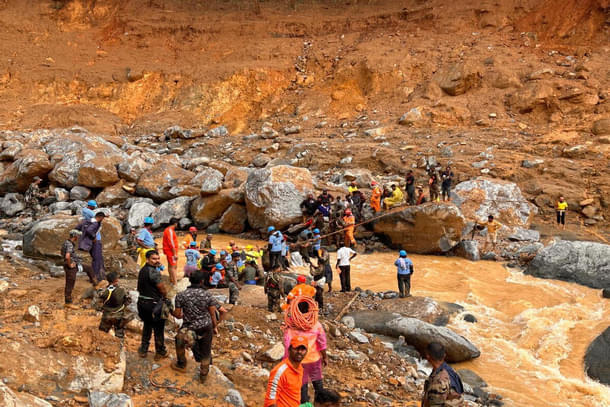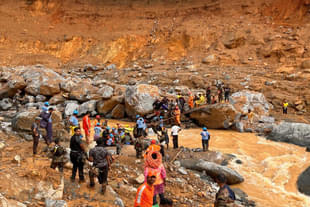Kerala
Church, Congress, And CPI (M) Opposed The Gadgil Report That Could Have Prevented The Wayanad Catastrophe
Swarajya Staff
Aug 06, 2024, 11:12 AM | Updated 11:12 AM IST
Save & read from anywhere!
Bookmark stories for easy access on any device or the Swarajya app.


The death toll in the landslide event which occurred in Wayanad district in the southern state of Kerala, as per reports, has reached 358, with 180 people yet to be found. According to official figures, 221 bodies and 166 body parts have been recovered to date.
Lives of nearly 5,000 people living in the villages of Mundakkai, Chooralmala, and Attamala along the banks of Chaliyar River and its tributaries were uprooted on 30 July after a series of landslides accompanied by heavy rains buried the hamlets under several feet of soil.
While rescue operations are underway with a large number of survivors having been shifted to government school buildings and other safe locations, the Communist Party of India (Marxist)-led Left Front government in Kerala is wary of the close attention the event has attracted from media and scientists alike.
Such was the panic in the state secretariat several hundred kilometres away in Thiruvananthapuram that the government issued a gag order trying to prevent scientists from visiting the disaster site and sharing their findings with the media.
Although the order was rescinded after a pushback, the otherwise vocal left-wing media outlets are maintaining a studied silence over the Left Front government’s failure to take corrective actions to prevent natural disasters despite the state having faced several episodes of flooding across the Left Front's two terms.
In the context of the Wayanad landslides, the failure of the previous Congress-led United Democratic Front (UDF) government as well as the incumbent Left Front government to implement the Gadgil and Kasturirangan committees’ recommendations deserves close scrutiny now.
An honest implementation of both the government panels' recommendations could have helped reduce the number of fatalities, if not the natural disaster, in Wayanad and other incidents across the state.
Gadgil’s Report on Kerala’s Ecological Sensitivity
Noted environmentalist Dr Madhav Gadgil in a recent article in the Indian Express pointed out that the site of the recent landslides in Wayanad is a part of the ‘Ecologically Sensitive Zones’ (ESZ) demarcated by the Western Ghats Ecology Expert Panel (WGEEP) headed by him.
The WGEEP was appointed by the then Congress-led Union Progressive Alliance (UPA) government at the centre in 2010 to assess the damage done to the natural habitat in the Western Ghats and to suggest measures to prevent the same in the future.
When its recommendations did not go down well with the political parties, another panel was appointed under the leadership of Dr Kasturirangan, which toned down the stringent measures suggested by the previous panel.
However, neither panel’s suggestions were honestly implemented by the state governments, especially Kerala.
In the article, Dr Gadgil also pointed out that one of the landslide-affected villages, Mundakkai, is only three kilometres away from Puthumala, which was affected similarly in the 2019 episode of landslides that claimed 17 lives. The environmentalist said that this was a reminder to all stakeholders to take the WGEEP’s findings seriously.
A look at the WGEEP report, also known as the Gadgil report, reveals that the entire Wayanad district spread across the slopes of the ecologically sensitive Western Ghats (which run north-south along the western coast of peninsular India) was identified as ecologically sensitive.
In fact, the Vythiri sub-district of Wayanad, which encompasses the three recent landslide-affected villages along with the other two sub-districts, Sulthan Bathery and Mananthavady, were all graded as ESZ-1, meaning that the ecological sensitivity of these areas was the highest.
.jpg?w=610&q=75&compress=true&format=auto)
As a whole, Kerala, according to the Gadgil report, has a total of 15 sub-districts graded as ESZ-1. The report recommended that the area for human activity and settlement be limited to only 40 per cent of the total area in each of these sub-districts.
Further, the Gadgil report graded two sub-districts in the state at ESZ-2 level and eight sub-districts at ESZ-3 as per their level of ecological sensitivity.
However, the gradation remained for the namesake, as just a few months after the final findings of the report were released, the report was challenged by multiple organisations.
Church Accuses Gadgil Panel
The influential Syro-Malabar Church fired the opening salvo in opposition to the Gadgil report.
While the churches adhering to the protestant denomination in the neighbouring Tamil Nadu and even catholic churches in Goa are vociferous in raising the banner against any developmental work, which supposedly damages the environment, the Catholic Syro-Malabar Church in Kerala opposed the Gadgil report tooth and nail.
In 2013, in an editorial in the ‘Laity Voice’, a magazine published by the religious body, the chief editor V C Sebastian alleged that the members of the Gadgil-led WGEEP had received kickbacks from foreign bodies and that their intentions behind categorising several areas in Kerala as ecologically sensitive were malafide.
The Syro-Malabar Church’s bone of contention was the Gadgil report's classification of the entire Christian-dominated district of Idukki as ESZ-1, along with a few sub-districts also having high Christian numbers, such as those in Thrissur, Kottayam and Pathanamthitta, having been graded as ESZ-1, ESZ-2, and ESZ-3.
The religious body, apart from making unfounded allegations against committee members, called the Gadgil report an ‘international conspiracy’ that was aimed against the Christian farmers, and alternatively, the church.
Congress and Left United Against the Report
If the Syro-Malabar Church stoking up tensions among the residents of the ecologically sensitive areas, where its followers had vast rubber and eucalyptus plantations, wasn’t enough, both the ruling Congress-led UDF as well as the CPI (M)-led Left Front opposition promised to scuttle the Gadgil report.
In the run-up to the 2014 Lok Sabha election, P C George, the Congress legislator and Chief Whip of the UDF government in the state declared, “We will physically beat back anyone who comes to our area to implement this report.”
Furthermore, Congress leader and former chief minister Oomen Chandy called an all-party meeting wherein leaders from both the sparring coalitions, who would otherwise prefer throwing brickbats, unanimously declared that the report’s findings ought to be junked and the same should be conveyed to the outgoing UPA government.
The CPI (M)-led Left Front even went a step further than the Congress.
In its Lok Sabha election manifesto, the CPI (M) announced that it was committed to rejecting Dr Gadgil’s recommendations and even that of the subsequently appointed Kasturirangan Committee that had toned down the stance.
As an alternative, it promised to appoint a new committee if voted to power at the centre, but that did not materialise. However, CPI (M) did manage to retain power in Kerala twice. Yet, no lessons were learnt.





